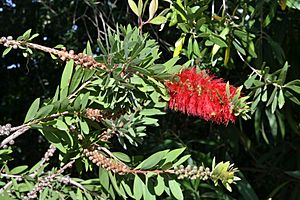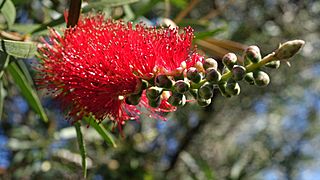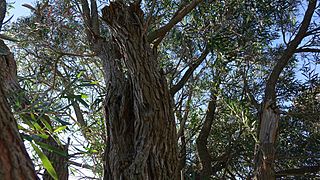Common red facts for kids
Quick facts for kids Crimson bottlebrush |
|
|---|---|
 |
|
| Melaleuca citrina flowers, fruit and foliage | |
| Scientific classification | |
| Genus: |
Melaleuca
|
| Species: |
citrina
|
| Synonyms | |
|
|
The Crimson Bottlebrush, also known as common red, crimson, or lemon bottlebrush, is a beautiful plant. Its scientific name is Melaleuca citrina. It belongs to the myrtle family, called Myrtaceae. This plant naturally grows only in New South Wales and Victoria in Australia.
The Crimson Bottlebrush is a strong and adaptable plant. You can find it often in its natural home. People grow it widely in gardens, not just in Australia but all over the world. It was one of the first Australian plants to be grown outside the country. A famous explorer named Joseph Banks took it to England in 1770. Its bright red flowers look like a bottlebrush, and they bloom for most of the year. This makes the plant very popular.
Contents
What Does the Crimson Bottlebrush Look Like?
The Crimson Bottlebrush is usually a shrub. It can grow up to 5 meters (about 16 feet) tall. But most often, it is about 1 to 3 meters (3 to 10 feet) high and wide. Its bark is tough and can be flaky or papery. When new parts of the plant grow, they are often covered with soft, silky hairs.
Leaves and Flowers
The leaves of this plant grow in a special way, one after another. They are about 2.5 to 10 centimeters (1 to 4 inches) long. They are also about 0.5 to 2.5 centimeters (0.2 to 1 inch) wide. The leaves are hard and flat. They are shaped like a narrow egg, with the narrower end near the base. The tip of the leaf is pointed but not sharp. If you look closely, you can see many small veins on both sides of the leaves. You can also see many tiny oil glands.
The flowers are bright red. They grow in spikes at the ends of branches. These branches keep growing even after the flowers bloom. Sometimes, flowers also grow where the leaves meet the stem. The flower spikes are about 4.5 to 7 centimeters (1.8 to 2.8 inches) across. They are also about 6 to 10 centimeters (2.4 to 4 inches) long. Each spike can have up to 80 individual flowers.
Each flower has small petals, about 4 to 6 millimeters (0.15 to 0.23 inches) long. These petals fall off as the flower gets older. Inside each flower, there are 30 to 45 stamens. Stamens are the parts that hold pollen. Their "stalks" are red, and their "tips" are purple. The plant blooms almost all year, but mostly in November and December.
Fruits
After the flowers, the plant grows woody, cup-shaped fruits. These fruits are called capsules. They are about 4.5 to 7 millimeters (0.17 to 0.27 inches) long. They are also about 7 millimeters (0.27 inches) wide. These capsules grow in groups along the stem. They stay closed until the plant, or the part of the plant holding them, dies.
How the Crimson Bottlebrush Got Its Name
The scientific name Melaleuca citrina was first officially described in 1802. A French botanist named Georges Louis Marie Dumont de Courset gave it this name. Before that, it was known as Metrosideros citrina. This earlier name was given by William Curtis in 1794.
The plant that Curtis studied grew from a root collected in 1770. This root was found at Botany Bay in Australia. It was collected by Joseph Banks during James Cook's first trip to Australia. Curtis noticed something special about the leaves. He wrote that "when bruised give forth an agreeable fragrance." The name citrina means "lemon-like." This refers to how the leaves smell, which is similar to citrus plants like lemons.
Today, many people still call this plant Callistemon citrinus. However, the Royal Botanic Gardens, Kew considers Callistemon citrinus to be the same plant as Melaleuca citrina.
Where Does the Crimson Bottlebrush Grow?
The Crimson Bottlebrush grows naturally near the coast in New South Wales. You can find it in places like the Blue Mountains. It also grows further inland in the Central Western Slopes. In Victoria, it grows in coastal areas. This plant likes to grow in wet places, like swamps and along creeks and rivers.
Animals and the Crimson Bottlebrush
Many birds love the Crimson Bottlebrush. They use it as a source of food. Some birds drink the sweet nectar from the flowers. These include eastern spinebills, New Holland honeyeaters, noisy miners, red wattlebirds, and silvereyes. Other birds, like crimson rosellas, enjoy eating the seeds from the plant's fruits.
Growing Crimson Bottlebrush in Gardens
The Crimson Bottlebrush is a very popular plant for gardens. It was already being grown in England by 1794. People often call it Callistemon citrinus or Callistemon lanceolatus when they talk about growing it.
It's easy to grow this plant from seeds or from cuttings (small pieces of the plant). It can grow in most types of soil. It prefers a sunny spot to grow best. The plant can handle frost and grows well with water and plant food. However, it is also tough and can survive dry periods and cold weather.
Popular Types of Crimson Bottlebrush
Gardeners have created different types of Crimson Bottlebrush, called "cultivars." Here are a few popular ones:
- Demesne Rowena: This type grows to about 1.5 meters (5 feet) tall and wide. Its flowers start red and then turn a deep pink.
- Firebrand: This plant is about 60 centimeters (2 feet) high and 2.5 meters (8 feet) wide. It has deep crimson-pink flowers.
- Splendens: This type grows in a neat, rounded shape. It reaches about 2 meters (6.5 feet) high and wide. In Australia, it's sold as "Endeavour." In the UK, it has won an award for being a great garden plant.
- White Anzac: This is a low, spreading type with white flowers. It was found growing naturally in New South Wales.
Gallery





